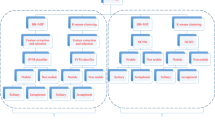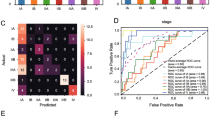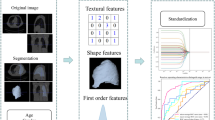Abstract
Lung cancer is one of the most lethal diseases across the world. Most lung cancers belong to the category of non-small cell lung cancer (NSCLC). Many studies have so far been carried out to avoid the hazards and bias of manual classification of NSCLC tumors. A few of such studies were intended towards automated nodal staging using the standard machine learning algorithms. Many others tried to classify tumors as either benign or malignant. None of these studies considered the pathological grading of NSCLC. Automated grading may perfectly depict the dissimilarity between normal tissue and cancer affected tissue. Such automation may save patients from undergoing a painful biopsy and may also help radiologists or oncologists in grading the tumor or lesion correctly. The present study aims at the automated grading of NSCLC tumors using the fuzzy rough nearest neighbour (FRNN) method. The dataset was extracted from The Cancer Imaging Archive and it comprised PET/CT images of NSCLC tumors of 211 patients. Accelerated segment test (FAST) and histogram oriented gradients methods were used to detect and extract features from the segmented images. Gray level co-occurrence matrix (GLCM) features were also considered in the study. The features along with the clinical grading information were fed into four machine learning algorithms: FRNN, logistic regression, multi-layer perceptron, and support vector machine. The results were thoroughly compared in the light of various evaluation-metrics. The confusion matrix was found balanced, and the outcome was found more cost-effective for FRNN. Results were also compared with various other leading studies done earlier in this field. The proposed FRNN model performed satisfactorily during the experiment. Further exploration of FRNN may be very helpful for radiologists and oncologists in planning the treatment for NSCLC. More varieties of cancers may be considered while conducting similar studies.








Similar content being viewed by others
References
Aggarwal P, Vig R, Sardana HK (2013) Patient-wise versus nodule-wise classification of annotated pulmonary nodules using pathologically confirmed cases. J Comput 8:2245–2255. https://doi.org/10.4304/jcp.8.9.2245-2255
Aha D, Kibler D (1991) Instance-based learning algorithms. Mach Learn 6:37–66
Alberg AJ et al (2005) Epidemiology of lung cancer: looking to the future. J Clin Oncol 23:3175–3185
American Joint Committee on Cancer (2010) AJCC cancer staging manual, 7th edn. Springer, New York
Bakr S, Gevaert O, Echegaray S, Ayers K, Zhou M, Shafiq M, Zheng H, Zhang W, Leung A, Kadoch M, Shrager J, Quon A, Rubin D, Plevritis S, Napel S (2017) Data for NSCLC radiogenomics collection. Cancer Imaging Arch. https://doi.org/10.7937/K9/TCIA.2017.7hs46erv
Burbidge R et al (2001) Drug design by machine learning: support vector machines for pharmaceutical data analysis. Comput Chem 26:5–14
Clark K et al (2013) The Cancer Imaging Archive (TCIA): maintaining and operating a public information repository. J Digit Imaging 26(6):1045–1057
Cohen Jacob (1960) A coefficient of agreement for nominal scales. Educ Psychol Meas 20(1):37–46. https://doi.org/10.1177/001316446002000104
Collobert R, Bengio S (2004). Links between perceptrons, MLPs and SVMs. Proc. Int’l Conf. on Machine Learning (ICML)
Cortes, Corinna, Vapnik Vladimir N (1995) Support-vector networks. Mach Learn 20(3):273–297. https://doi.org/10.1007/bf00994018
Cox DR (1958) The regression analysis of binary sequences (with discussion). J R Stat Soc B. 20(2):215–242 (JSTOR 2983890)
da Silva GLF, da Silva Neto OP, Silva AC, de Paiva AC, Gattass M (2017) Lung nodules diagnosis based on evolutionary convolutional neural network. Multimed Tools Appl 76:19039–19055. https://doi.org/10.1007/s11042-017-4480-9
Dalal N, Triggs B (2005) Histograms of oriented gradients for human detection, IEEE Computer Society Conference on Computer Vision and Pattern Recognition, Vol. 1 (June 2005), pp 886–893
Dhara AK, Mukhopadhyay S, Dutta A, Garg M, Khandelwal N, Kumar P (2016) Classification of pulmonary nodules in lung CT images using shape and texture features. Medical imaging; Proceedings of the computer-aided diagnosis; San Diego, CA, USA. 24 March 2016
Gevaert O et al (2012) Non–small cell lung cancer: identifying prognostic imaging biomarkers by leveraging public gene expression microarray data—methods and preliminary results. Radiol Radiol Soc North America (RSNA). https://doi.org/10.1148/radiol.12111607
Gleason, Donald F, Mellinger George T (2002) Prediction of prognosis for prostatic adenocarcinoma by combined histological grading and clinical staging1974. J Urol (United States) 167(2):953–958. https://doi.org/10.1016/s0022-5347(02)80309-3 (Discussion 959)
Horn L et al (2014) Cancer of the lung: non-small cell lung cancer and small cell lung cancer. In: Niederhuber JE, Armitage JO, Doroshow JH, Kastan MB, Tepper JE (eds) Abeloff’s clinical oncology, 5th edn. Elsevier, Philadelphia, pp 1143–1192
Htwe KZ, Yamamori K, Katayama T, Kyi TM (2016) Automated lung nodule classification by artificial neural network and fuzzy inference system; Proceedings of the 2016 IEEE 5th Global Conference on Consumer Electronics (GCCE); Kyoto, Japan. 11–14 October 2016; pp 1–2
Huang W, Tu S (2016) Malignancy classification for small pulmonary nodules with radiomics and logistic regression. Med Phys 43:3377–3378. https://doi.org/10.1118/1.4955794
Hyndman RJ, Koehler AB (2006) Another look at measures of forecast accuracy. Int J Forecast 22(4):679–688. https://doi.org/10.1016/j.ijforecast.2006.03.001
Jensen R, Cornelis C (2008) A new approach to fuzzy-rough nearest neighbour classification. In: 6th International Conference on Rough Sets and Current Trends in Computing, pp 310–319
Jensen R, Cornelis C (2011) Fuzzy-rough nearest neighbour classification and prediction. Theor Comput Sci 412(42):5871–5884. https://doi.org/10.1016/j.tcs.2011.05.040
Kuruvilla Jinsa, Gunavathi Kandasamy (2015) Lung cancer classification using fuzzy logic for CT images. IJMEI 7:233–249
le Cessie S, van Houwelingen JC (1992) Ridge estimators in logistic regression. Appl Stat 41(1):191–201
Ma JC, Wang Q, Ren Y, Hu H, Zhao J (2016) Automatic lung nodule classification with radiomics approach; proceedings of the medical imaging 2016: PACS and imaging informatics: next generation and innovations; San Diego, CA, USA. 5, April 2016
Mao KM, Deng ZF (2016) Lung nodule image classification based on ensemble machine learning. Med Imaging Health Inform 6:1679–1685
MATLAB and Statistics Toolbox Release (2015) the MathWorks Inc. Natick, Massachusetts
McNitt-Gray MF, Wyckoff N, Sayre JW (1999) The effects of co-occurrence matrix based texture parameters on the classification of solitary pulmonary nodules imaged on computed tomography. Comput Med Imaging Graph 23:339–348. https://doi.org/10.1016/s0895-6111(99)00033-6
Mohanaiah P et al (2013) Image texture feature extraction using GLCM approach. Int J Sci Res Publ 3(5):1 (ISSN 2250–3153)
Moitra Dipanjan (2017a) Segmentation strategy of pet brain tumor image. Indian J Comput Sci Eng 0976–5166(8):575–577
Moitra Dipanjan (2017b) Review of Brain Tumor Detection using Pattern Recognition Techniques. Int J Comput Sci Eng 5(2):121–123 (ISSN: 2347–2693)
Moitra D (2018) Comparison of multimodal tumor image segmentation techniques. Int J Adv Res Comput Sci 9(3):129–131. https://doi.org/10.26483/ijarcs.v9i3.6010 (ISSN: 0976–5697)
Moitra D (2019) Classification of malignant tumors: a practical approach. LAP LAMBERT Academic Publishing, Cambridge (ISBN: 978-613-9-47500-1)
Moitra D, Mandal RK (2019) Automated AJCC staging of non-small cell lung cancer (NSCLC) using deep convolutional neural network (CNN) and recurrent neural network (RNN). Health Inf Sci Syst 7:14. https://doi.org/10.1007/s13755-019-0077-1
Namin ST, Moghaddam HA, Jafari R, Esmaeil-Zadeh M, Gity M (2010) Automated detection and classification of pulmonary nodules in 3D thoracic CT images; Proceedings of the 2010 IEEE International Conference on Systems, Man and Cybernetics (SMC); Istanbul, Turkey. 10–13 October 2010; pp 3774–3779
Nivetha P, Manickavasagam R (2014) Cancer detection at early stage using PET/CT imaging technique. Int J Innov Res Comput Commun Eng 2(3):3358–3363 (ISSN: 2320–9798)
Orozco H, Villegas O, Dominguez H, Sanchez V (2013) Lung nodule classification in CT thorax images using support vector machines, in 2013 12th Mexican International Conference on Artificial Intelligence (MICAI), México, Mexico, 2013 pp 277–283. https://doi.org/10.1109/micai.2013.38
Otsu N (1979) A Threshold selection method from gray-level histograms. IEEE Trans Syst Man Cybern 9(1):62–66
Pawlak Z (1982) Rough sets. Int J Comput Inf Sci 11:341–356
Pearson K (1901) On lines and planes of closest fit to systems of points in space. Philos Mag 2(11):559–572. https://doi.org/10.1080/14786440109462720
Powers DMW (2011) Evaluation: from Precision, Recall and F-measure to ROC, informedness, markedness and correlation. J Mach Learn Technol 2(1):37–63 (2007)
Rosten E, Drummond T (2006) Machine learning for high-speed corner detection. 9th European Conference on Computer Vision. Vol. 1, 2006, pp 430–443
Sajda P (2006) Machine learning for detection and diagnosis of disease. Annu Rev Biomed Eng 8:8.1–8.29. https://doi.org/10.1146/annurev.bioeng.8.061505.095802
Sarkar Manish (2007) Fuzzy-rough nearest neighbor algorithms in classification. Fuzzy Sets Syst 158:2134–2152
Sharma Neeraj et al (2008) Segmentation and classification of medical images using texture-primitive features: application of BAM-type artificial neural network. J Med Phys 33(3):119–126. https://doi.org/10.4103/0971-6203.42763
Shen W, Zhou M, Yang F, Yang CY, Tian J (2015) Information processing in medical imaging. Springer, Cham, pp 588–599 (Multi-scale convolutional neural networks for lung nodule classification)
Sivakumar S, Chandrasekar C (2013) Lung nodule detection using Fuzzy Clustering and support vector machines. Int J Eng Technol (IJET). 5(1):179–185 (ISSN: 0975–4024)
Song D, Zhukov TA, Markov O, Qian W, Tockman MS (2012) A new method for lung cancer prognosis via centrosome image feature analysis. Anal Quant Cytopathol Histpathol 34(4):180–188
Song C, Stephanie H, Timothy P (2017) Diagnostic classification of solitary pulmonary nodules using dual time F-18-FDG PET/CT image texture features in granuloma-endemic regions. Sci Rep 7:9370
Taher F, Werghi N, Al-Ahmad H (2012) Bayesian classification and artificial neural network methods for lung cancer early diagnosis 2012 19th IEEE International Conference on Electronics, Circuits, and Systems (ICECS 2012), Seville, 2012, pp 773–776. https://doi.org/10.1109/icecs.2012.6463545
Walczak B, Massart DL (1999) Rough sets theory. Chemom Intell Lab Syst 47:1–16
Waikato Environment for Knowledge Analysis version 3.7.2 (2019) The University of Waikato, Hamilton, New Zealand
Zadeh L (1965) Fuzzy sets. Inf Control 8:338–353
Zhao XZ, Liu LY, Qi SL, Teng YY, Li JH, Qian W (2018a) Agile convolutional neural network for pulmonary nodule classification using CT images. Comput Assist Radiol Surg 13:585–595. https://doi.org/10.1007/s11548-017-1696-0
Zhao XZ, Liu LY, Qi SL, Teng YY, Li JH, Qian W (2018b) Agile convolutional neural network for pulmonary nodule classification using CT images. Comput Assist Radiol Surg 13:585–595. https://doi.org/10.1007/s11548-017-1696-0
Author information
Authors and Affiliations
Corresponding author
Additional information
Publisher's Note
Springer Nature remains neutral with regard to jurisdictional claims in published maps and institutional affiliations.
Rights and permissions
About this article
Cite this article
Moitra, D., Mandal, R.K. Automated grading of non-small cell lung cancer by fuzzy rough nearest neighbour method. Netw Model Anal Health Inform Bioinforma 8, 24 (2019). https://doi.org/10.1007/s13721-019-0204-6
Received:
Revised:
Accepted:
Published:
DOI: https://doi.org/10.1007/s13721-019-0204-6




